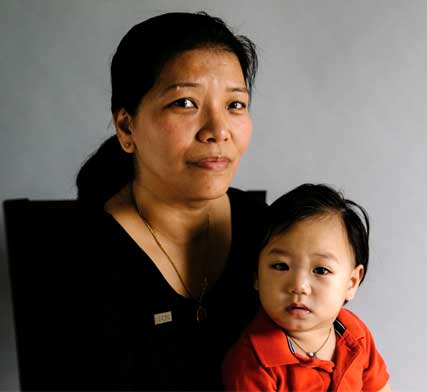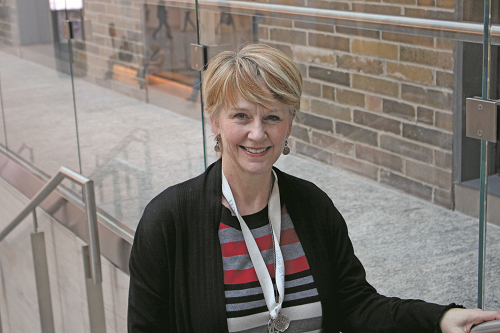
Ten months after RN Lhamo Dolkar gave birth to her fourth child and began to battle depression, she went public, fighting tears to share her story, hopeful that she can help others avoid an illness that can sometimes consume the lives of mothers and children.
Dolkar spoke of her struggles in October, when RNAO announced the release of its second edition Assessment and Interventions for Perinatal Depression best practice guideline (BPG). “People expect (me) to be strong,” she said. “(I’ve) always been strong…Mothers are the foundation of families.”
Years earlier in Quebec, that maternal foundation nearly crumbled for another family, despite the efforts of Teresa Bandrowska, who for 28 years had cared for babies and their mothers, first as a perinatal nurse in Quebec, then as a midwife who helped to persuade Ontario to license those health-care professionals. She is now lead midwife at the Ottawa Birth and Wellness Centre, and was on the expert panel that helped create the revised BPG.
But Bandrowska’s experience and knowledge almost came up short when, in 2010, she tried to save the life of her daughter after the birth of her first grandchild.
Her daughter’s family doctor dismissed her dark moods and increasing insomnia as anxiety. Bandrowska and her husband, also a nurse, tried to find a psychiatrist or psychologist in the community who would treat their daughter, but all said they lacked space to add a patient.
Assessment and Interventions for Perinatal Depression best practice guideline
Key findings and recommendations...
- Those who face social inequities are at greater risk of perinatal depression; that risk is doubled for people with lower incomes compared to those in the middle class.
- Canada should institute universal screening of perinatal depression before and after birth.
- Care providers need to be educated about and receive ongoing professional development for perinatal depression.
- Those providing treatment must approach each mother and family holistically, and consider cultural values.
- Women should be empowered to make informed decisions among treatment options.
- Mothers must be educated on how to reduce risks by getting sufficient sleep and exercise, and seeking social supports.
Then one night, Bandrowska got a panicked call from her son-in-law. Her daughter was hysterical and saying she would kill herself. With nowhere else to go, Bandrowska brought her into the local hospital emergency department, where she was met with derision. ‘Why are you crying?’ Bandrowska recalls an ill-informed doctor asking. ‘You can’t come to emergency just because (you’re) sad.’
Upon urging from Bandrowska, the hospital admitted her daughter, but only to the pediatric ward, then into a general medicine ward next to an elderly man. Four nights she went without sleep. Four days she expressed suicidal intentions and waited to be evaluated by someone with expertise in mental health, something the hospital said would not happen until she was admitted to the psychiatric floor.
“All she thought about was trying to kill herself,” Bandrowska recounts. “I couldn’t understand why a psychiatrist couldn’t come to another floor.”
Appropriate care was finally provided only after Bandrowska’s eldest daughter, a social worker, issued an ultimatum to the nursing co-ordinator: Treat my sister or move her to another hospital that will.
From her first symptoms of depression until her first psychiatric treatment three months later, her daughter was pushed to the brink by a health-care system that lacked services for, and knowledge about, perinatal mood disorders. “She kept deteriorating. It was terrifying and heartbreaking,” Bandrowska says.
Obstetrics RN and educator Angela Bowen co-chaired the BPG panel. Bowen has led her community of Saskatoon to become a benchmark in Canada for preventing and treating perinatal depression. In her early years as a nurse, Bowen confronted physical health emergencies that sometimes came with pregnancy and delivery, but even though she had also worked as a mental health nurse, she knew little about the connection between mood disorders, pregnancy and the postpartum period.
When she decided to pursue her PhD in 2002, she recoiled when someone suggested she evaluate a postpartum depression program. “I didn’t see it as exciting,” she says.
Her outlook changed as she began research later published in peer-reviewed journals.
She found that perinatal depression was the leading obstetrical complication, and far too often, it was missed.
Those in obstetrics saw it as an issue for psychiatrists who too often dismissed it as baby blues rather than depression, says Bowen, who worked on the BPG with fellow co-chair Phyllis Montgomery, a professor at the school of nursing at Laurentian University in Sudbury.
Even when doctors prescribe anti-depressants they often give low doses because they worry medications might harm developing children. But those same children face risks when their mothers aren’t treated for depression or are given less than the needed dose, Bowen says.
When pregnant women feel stress, their bodies can produce more cortisol, a hormone that, if elevated, has been found through research to triple the chances that later in life a baby girl will develop depression, and a baby boy, attention deficit hyperactivity disorder, Bowen says.
Canada lags behind other countries
When it comes to preventing and treating perinatal depression, Canada should look beyond its borders to countries that are well ahead, experts say.
In Australia, hospitals have wards designed so that an ill mom and her child can be kept together. This does not happen in Canada, says Angela Bowen, co-chair of RNAO’s Assessment and Interventions for Perinatal Depression best practice guideline (BPG).
Canadian leaders don’t grasp the extent of harm caused by the lack of care here because no one measures the impact, Bowen suggests. When a mother or expecting mother kills herself, the role played by depression too often goes unrecorded unless her death was in a public place. The U.K. is far ahead on that count, she adds.
In developed countries, perinatal depression is one of the most frequently under-diagnosed pregnancy complications. About 10 per cent of individuals during pregnancy, and 13 per cent during early postpartum, experience a mental illness, primarily depression.
“If the mom isn’t (adequately) treated, the child is worse off,” she says.
The risk is staggering. One-in-five new moms are at risk for perinatal mood disorders. When they become ill, their partners are more likely to suffer with mental illness too. This risk is not just the result of changes in hormones. New moms who are depressed are less likely to bond with or successfully breastfeed their children, shortfalls that place developing children at greater risk of physical and emotional ailments. Even parents who adopt children are at greater risk than adults without children to develop a mood disorder.
The revised RNAO BPG expands the scope of an earlier BPG to include all members of the health-care team as well as women not only up to one year postpartum, but during pregnancy as well. “The goal is to prevent perinatal depression or lessen its impact by screening, assessing, evaluating and treating women who are pregnant or postpartum,” explains RNAO manager Katherine Wallace, who served as the guideline’s development lead.
As an RN and previously a practising midwife, Wallace knows some pregnant women and new mothers won’t admit they are depressed because they fear someone might take their babies. Some also are afraid of admitting they may be suffering with depression because they don’t want to become a target of stigma.
That stigma is something nurses and others on a health-care team must learn to avoid, notes the BPG, so they can approach mothers with both knowledge and compassion. We live in a culture that expects a new parent to feel joy and excitement, but that is not the experience of all new parents. “Too often the cultural expectation for mothers is (they) should just be thankful,” Wallace says.
Bowen agrees. “(Society) idealizes motherhood,” she says.
That was the experience of Dolkar, who was just 17 and the oldest of three sisters in Mumbai, India, when her father died. “I didn’t have time to cry…I couldn’t do anything wrong because I didn’t want to let my family down,” she recalls.
She found a role model in her mother, who ran a business out of the family kitchen, producing noodles for restaurants. The young Dolkar became a homeopath, and then in 2009, immigrated to Canada to meet a young man whom she had known from a distance. They married, and in the following six years, she welcomed three sons, each born premature and spending weeks in a neonatal intensive care unit. She did all this while working and simultaneously earning her nursing degree at Ryerson University. She landed her first nursing job at St. Michael’s Hospital in Toronto in 2015.
Just as life was settling, Dolkar found out she was pregnant again in 2017. It was something she hadn’t planned. Determined to avoid another pre-term birth, she set her mind to carry to full-term, but paid a psychological price. “It created extra stress,” she admits.
Dolkar’s fourth son Jigther was born Dec. 24, 2017, but a menacing challenge lay ahead.
Things that had never troubled her before – from squabbles between her sons to messes left in the home – were too much to bear. She slammed doors, screamed, broke down crying and felt an urge to push her sons on to their beds. While she resisted the latter, she was despondent.
It was only after she started to open up to others about her struggles that her outlook started to change. “I realized that being strong doesn’t mean always being able to find a solution.”
As a member of RNAO’s board of directors (Region 7 representative), Dolkar hopes sharing her experience will help others. That goal of helping is the broader purpose of the BPG. Its most crucial recommendation is to routinely screen for depression during pregnancy and postpartum because stigma and fear may deter some from admitting how they feel.
Bowen, who is a nursing professor at the University of Saskatchewan, brings a wide lens to the issue after having worked in Ontario, Alberta, British Columbia and Saskatchewan. On her home turf in Saskatoon, expectant mothers are screened three times for perinatal mood disorders, twice during pregnancy and once postpartum.
“We are trying to get a national strategy,” Bowen says. She’s hopeful the new BPG will spark that effort and empower nurses and others on the frontlines to advocate for change in their own hospitals and communities. “People look to RNAO for guidance,” she says. This BPG “…is a document that (nurses) can take to their supervisors and organizations to advocate for best practices.”
Some nurses assume that because they know so much about pregnancy and birth, they are insulated from the risks of postpartum depression, Bowen says.
But knowledge isn’t a shield against mental illness.
That’s something obstetrical RN and BPG expert panel member Sue Bookey-Bassett learned the hard way. It was Nov. 19, 1999 when she gave birth to her first child. The second night home, Bookey-Bassett couldn’t get her daughter to settle and stop crying, so at 4 a.m., she and her husband drove to the hospital. Staff fed the baby with formula and burped her, and soon after, she fell asleep.
“That made me feel like I wasn’t a competent mom,” Bookey-Bassett says now. As she was nearing the end of her first week home with her baby, she was both sad and surprised that she could feel that way. “It was a bit shocking. I was a nurse. I should know what to do.”
As weeks passed, Sue’s sadness continued. “On a sunny day in December, I took her on a walk in her stroller. I was crying the whole time, thinking, I should be happy.” As Christmas approached, Bookey-Bassett’s anxiety grew. That’s when she phoned a public health nurse, asked a friend to stay with her, and contacted her family doctor, who prescribed an anti-depressant. Gradually, the sadness and anxiety subsided.
Two years later, she was in hospital giving birth to a son. On her chart, someone noted she had suffered with depression after her first child. But no one at the hospital asked what sort of social supports might be waiting for her when she returned home with her son.
“That was (inappropriate) nursing, if you ask me,” Bookey-Bassett says. “I wrote a letter to the chief of nursing.”
Oversights are all-too-common in Ontario, which lacks standardized supports and practices to guard against perinatal mood disorder, says Linda Rankin, also a member of the BPG expert panel and a social worker who is trying to improve the approach to this issue in northern Ontario.
Sporadically since 2003, the province has funded efforts in Muskoka and Timiskaming, but when that funding dried up, so too did the services. Even when they are running, Rankin says, they are out of reach for most in northern Ontario. “We called it the postal code lottery,” she says. Provincial funds also were used to create a postpartum strategy for northeastern Ontario, and later, all of northern Ontario, but no money came to implement it.
“Service providers are overwhelmed with the volume of families suffering from this mental illness with so few dedicated services available. Everyone is desperately trying to help these families,” Rankin says.
Toronto Public Health, an RNAO Best Practice Spotlight Organization (BPSO), screens women prenatally and in the postpartum period, but most of the latter is done a day or two after birth, which is before postpartum depression typically develops, says its associate director So-Yan Seto. There aren’t enough psychiatrists to assess and treat perinatal depression, she says. Only three hospitals in Toronto offer specialized perinatal programs for in-patients, and mothers are reluctant to seek help because those programs separate mothers from their babies.
It’s important for providers to screen everyone, reduce stigma, and identify depression early to reduce its severity and effects on children’s health and development, Seto says.
The risks to mothers and their children can be reduced if the recommendations in the BPG are implemented, Wallace says. “If we detect this earlier, the progression of the illness will not be as severe.”
That’s what motivated RNAO to publish its second edition of this critical BPG, and create webinars. The former will drive changes in policy, and the latter will empower women and their families to make choices that will better their lives.


